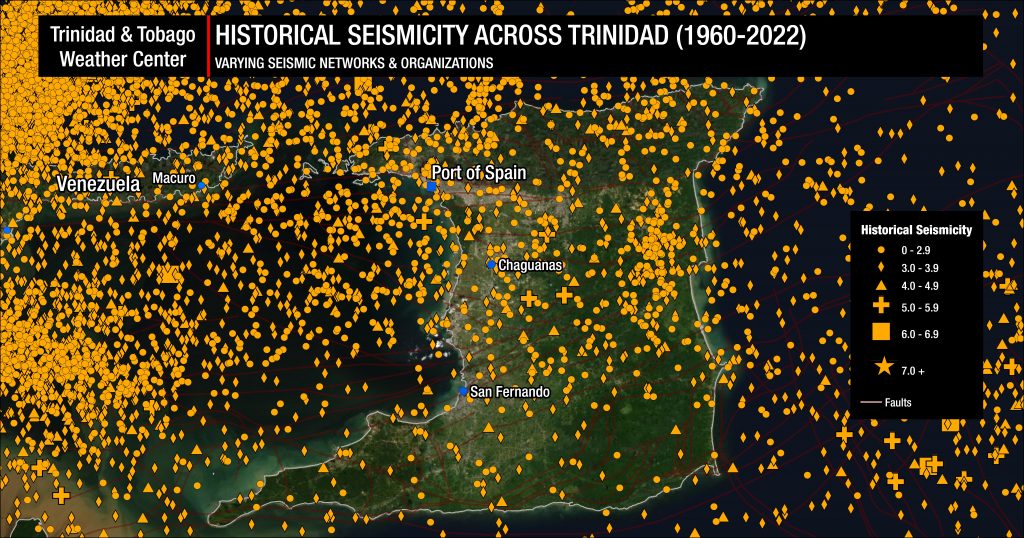At 1:52 PM Tuesday, March 19th, 2024, the University of the West Indies Seismic Research Centre (UWI SRC) recorded a light earthquake of magnitude 4.7 (mt) southwest of Grenada.
The earthquake was located at 63.31°W and 18.910°N, approximately 25.94 kilometers west-southwest of St. Georges, Grenada, 150.93 kilometers south-southwest of Kingstown, St. Vincent and the Grenadines, and 157.74 kilometers north-northwest of Port of Spain, Trinidad and Tobago. It was located at a depth of 128.9 kilometers and well away from Kick’em Jenny, a submarine volcano located northwest of Grenada.

The UWI SRC, the authority on seismic and volcanological information in the English-speaking Eastern Caribbean, has reviewed this information.
Shaking was reported across northwestern Trinidad and parts of Grenada. You can submit felt reports to the University of the West Indies Seismic Research Centre.
There is no tsunami threat.
There are four conditions necessary for an earthquake to cause a tsunami:
- The earthquake must occur beneath the ocean or cause material to slide within or into the ocean.
- The earthquake must be strong, with at least a magnitude of 6.5.
- The earthquake must rupture the Earth’s surface and occur at a shallow depth—less than 70 kilometers below the surface.
- The earthquake must cause vertical movement of the seafloor (up to several meters).
None of these conditions occurred.
Note that different seismic monitoring agencies use different methods, or several methods, for processing quake parameters worldwide. Each method has its limitations and will likely produce different results within the range of the data’s uncertainty. This is generally accepted within the scientific community.
Read More
Earthquake Magnitude & Intensity
Can earthquakes be predicted or forecasted?
43 events have been recorded within 20 kilometers of Tuesday afternoon’s earthquake. The largest recorded event within 20 kilometers of Tuesday’s quake occurred on February 24th, 1918, registering an estimated magnitude of 6.2 on the Richter Scale, but since instruments have existed in the region, the largest recorded event registered at a magnitude of 5.1, occurring on May 31st, 1987. Seismic events in this area generally occur at depths between 90 and 161 kilometers.
Has there been an increase in seismic activity?

Trinidad and Tobago and the surrounding region are very seismically active. Across the Eastern Caribbean, over 2,200 earthquakes are recorded annually. Since 1990, the University of the West Indies Seismic Research Centre has recorded an annual average of 280 earthquakes in the Trinidad and Tobago region (area bounded by 9.5°- 11.5°N & 59.5°W – 63.5°W). Of these 280 quakes, 50 of these seismic events are, on average, above magnitude 3.5.
Most earthquakes occur northwest of Trinidad in an area known as North of the Paria Peninsula, which has the second-highest seismicity in the Eastern Caribbean. According to the UWI SRC, approximately 65 events of magnitude 2.1 and above are located in the area annually.
However, the UWI SRC’s annual report for 2020 to 2021 states that regional seismic and volcanic activity has been elevated for several years.
On average, the Eastern Caribbean has seen a pattern of major (M7.0-M7.9) quakes every 20 to 30 years. That pattern has stayed true. The last major (M7.0-7.9) quake occurred north of Martinique in 2007.
Historical patterns indicate that great quakes (M8.0+) on the Richter Scale have occurred every century in the region. The probability of another event at that level is high since the last >M8.0 earthquake occurred in 1843. While it is impossible to say definitively when the next great quake will occur in the region, the time since the last one is now more than 170 years ago.
It is important to note seismic activity *cannot* be predicted – meaning the precise time, date, magnitude, depth, etc., cannot be known ahead of time based on current research and technology.
Now is the time to create or go over your earthquake preparedness plan and know what to do during, before, and after an earthquake.












